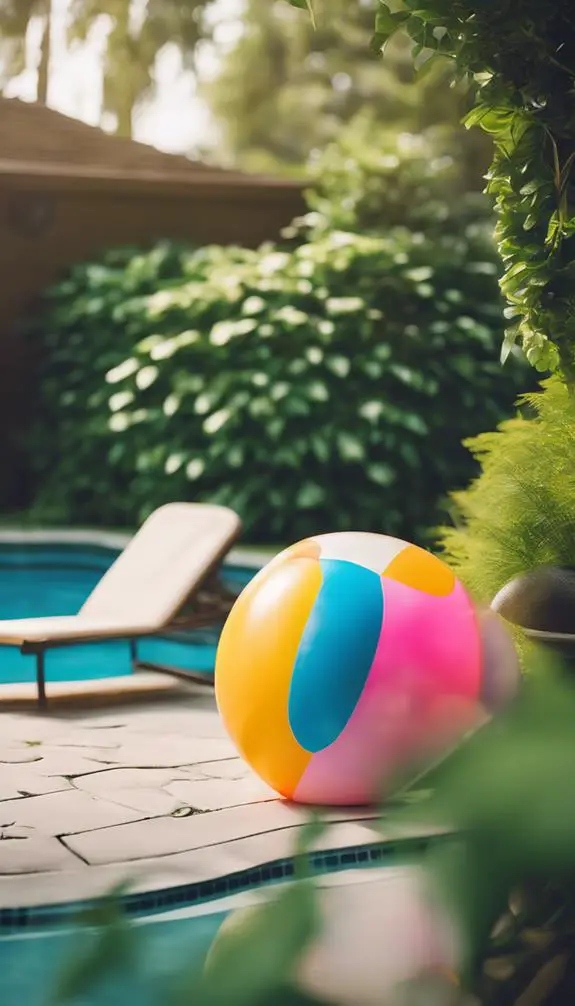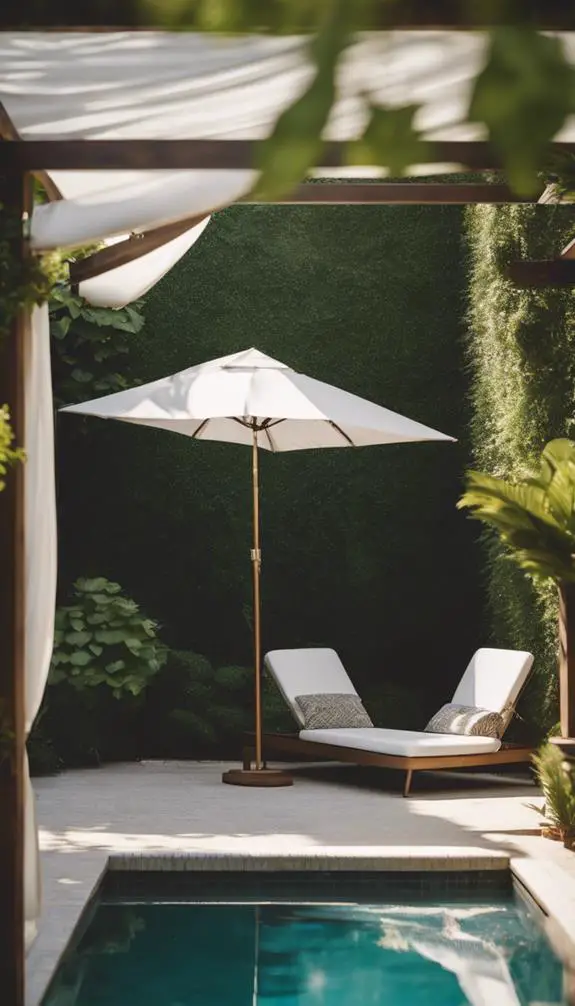You're enthusiastic to turn your tiny outdoor space into a serene oasis, but where do you start? Don't let limited square footage hold you back – with the right strategies, you can create a beautiful and functional garden. From clever vertical gardening solutions to space-saving planter ideas, there are plenty of ways to make the most of your compact patio. You'll be surprised at how a few thoughtful design elements can transform your small garden into a haven that's perfect for relaxation and entertainment. Want to learn more?
Summary
- Utilize vertical gardening and space-saving solutions like wall planters, trellis systems, and planter pockets to maximize space in small gardens.
- Optimize patio layouts with circular seating patterns, multi-functional furniture, and compact planters to create a functional and visually appealing space.
- Select low-maintenance, high-yielding plants like succulents or air plants that thrive in small spaces and require minimal care.
- Create a functional and stylish outdoor space with upcycled pallet furniture, DIY decor hacks, and strategic lighting that showcases the garden's features.
- Implement a thoughtful care routine, including pruning, fertilizing, and protecting plants, to ensure a thriving and beautiful small garden.
Vertical Gardening Solutions

Frequently, small gardens lack the horizontal space to accommodate a variety of plants, but vertical gardening solutions can help maximize your garden's potential.
You can utilize wall planters, which are mounted directly onto your garden's walls, providing ample space for plants to grow upwards. These planters often feature built-in water reservoirs and aeration systems, ensuring your plants receive the necessary nutrients.
Alternatively, you can install trellis systems, which provide structural support for climbing plants like ivy, clematis, or roses. Trellis systems can be freestanding or attached to walls, and come in a range of materials, such as wood, metal, or plastic.
Space-Saving Planter Ideas
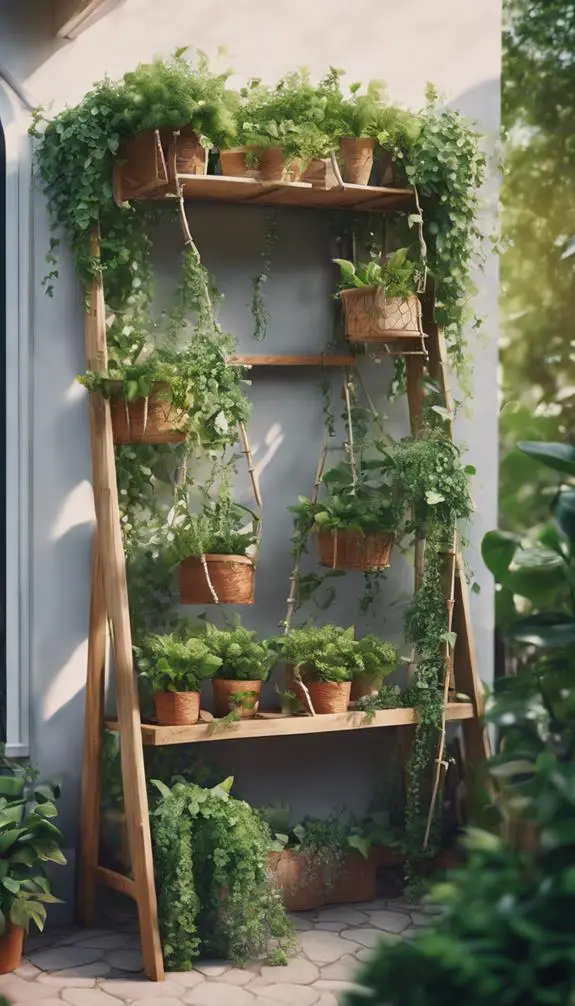
Because every inch counts in a small garden, selecting the right planters is essential for maximizing space.
You'll want to opt for Space Savers that make the most of your garden's vertical real estate. Consider using planter pockets, which can be attached to walls or fences, providing ample room for plants to grow while keeping the floor clear.
These clever containers are perfect for herbs, succulents, or flowering plants. For added efficiency, look for planters with built-in irrigation systems or self-watering technology.
Compact Patio Designs
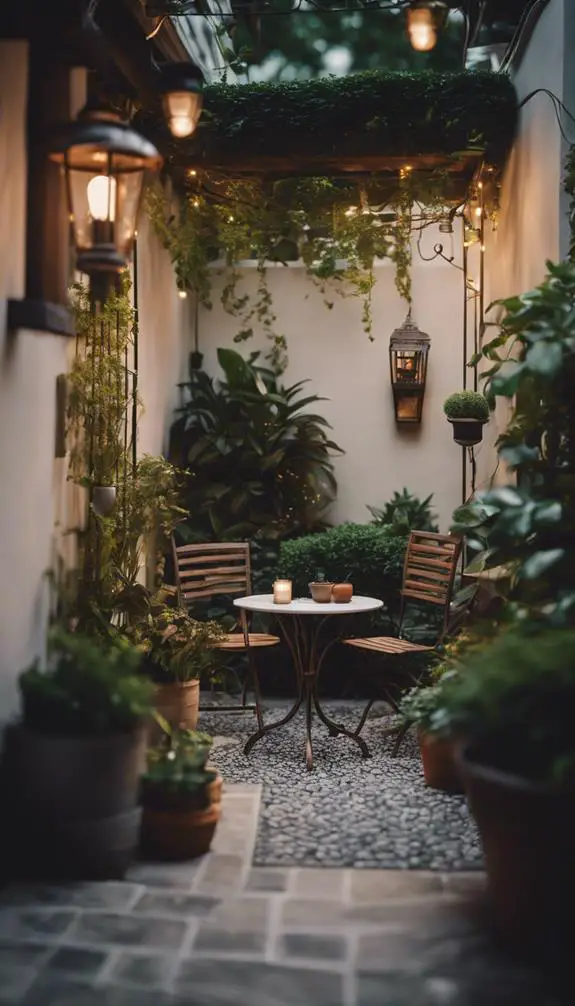
You'll want to optimize your patio furniture arrangement to create a sense of flow and functionality in a compact space.
Consider a circular seating pattern to encourage conversation, and balance larger pieces with smaller scale accents.
Patio Furniture Arrangement
A modest patio calls for a thoughtful furniture arrangement to maximize its compact space.
You'll want to create a patio layout that flows seamlessly, allowing for effortless movement between seating areas, dining spaces, and any other zones you've designated. Consider a circular or oval shape for your patio layout, as these can create a sense of visual harmony in small spaces.
When choosing furniture styles, opt for sleek, low-profile pieces that don't visually clutter the area. Consider multi-functional pieces, like a storage bench or a coffee table with built-in planters, to enhance functionality without sacrificing style.
Small Space Layout
Designing a compact patio layout requires careful consideration of spatial relationships and traffic flow.
You'll want to create a functional and visually appealing space that accommodates your needs. Start by defining different areas within your patio using garden paths, which can help guide traffic and create separate zones.
Make the most of corner plots by incorporating built-in seating or planters that maximize space. Consider a circular or curved layout to soften the edges of your patio and create a sense of flow.
Don't forget to leave enough space between furniture and paths for comfortable movement. By carefully planning your compact patio layout, you can create a beautiful and functional outdoor space that you'll love spending time in.
Small Herb Garden Inspiration
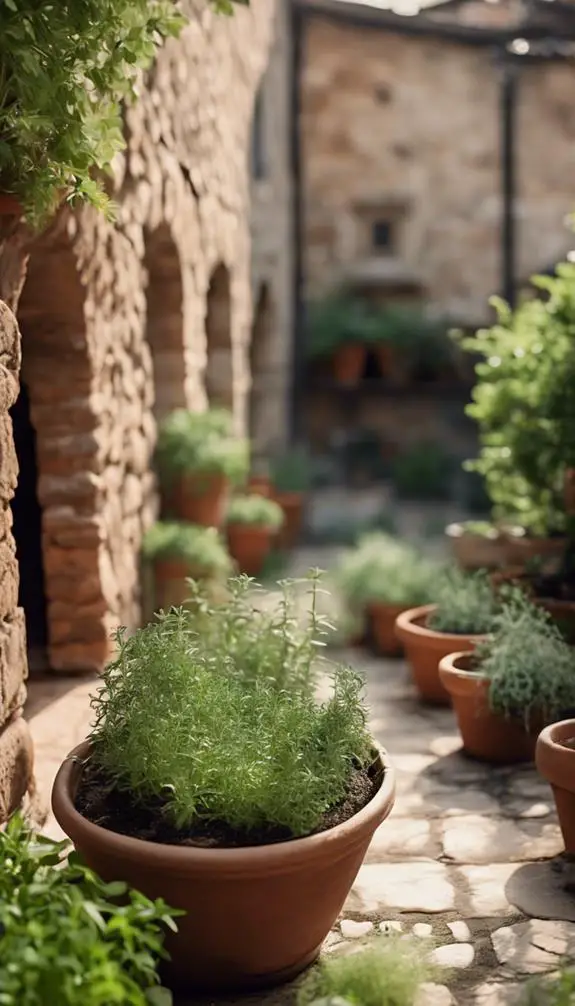
You'll want to start by selecting a variety of fresh herbs that'll thrive in your small garden, considering factors like climate, sunlight, and maintenance needs.
Next, choose a container garden design that complements your space, whether that's a compact vertical planter or a rustic wooden box.
To guarantee a bountiful harvest year-round, you'll need to develop a care routine that includes pruning, fertilizing, and protecting your herbs from extreme temperatures and pests.
Fresh Herb Selections Guide
Three to five herb varieties are all you need to create a functional and visually appealing small herb garden.
You can choose a mix of fragrant herbs like lavender, rosemary, and thyme, which not only add aroma but also attract pollinators.
Consider herb pairings that complement each other with regard to growth habits, sunlight requirements, and watering needs.
For example, pair sprawling herbs like mint with upright ones like basil or cilantro.
Don't forget to include a few versatile herbs like parsley, which can be used in a variety of dishes.
Container Garden Designs
With a thoughtful selection of herbs in place, it's time to ponder the vessel that will showcase your small herb garden.
You'll want a container that complements your herb selection while adding visual appeal to your outdoor space. Consider a planter that's at least 6-8 inches deep to provide adequate root growth.
Add potted flowers around the base to create a vibrant, layered look. Incorporate garden accents like decorative stones or moss to fill in gaps and soften the overall appearance.
Think beyond traditional planters, too – an old wooden crate or vintage colander can add a touch of whimsy to your design. Ultimately, your container choice should reflect your personal style and the unique character of your small herb garden.
Year-Round Herb Care
Now that your container herb garden is thriving, it's time to focus on maintaining its essentialness throughout the year.
To achieve year-round freshness, you'll need to implement regular herb pruning and seasonal harvesting techniques.
Prune your herbs regularly to encourage bushy growth and prevent them from flowering.
Pinch or cut off flower buds to direct the plant's energy towards leaf production.
For seasonal harvesting, divide your herbs into cool-season and warm-season crops.
Cool-season herbs like parsley and cilantro thrive in spring and fall, while warm-season herbs like basil and mint love summer's heat.
Harvest your herbs in the morning, after the dew has dried but before the heat becomes intense, to certify maximum flavor and aroma.
DIY Garden Furniture Hacks

Pallets piled up in your backyard or garage can be repurposed into functional and stylish garden furniture with a little creativity and elbow grease.
You can transform an upcycled pallet into a rustic bench by attaching reclaimed wood slats to the pallet frame, adding cushions for comfort.
For a more modern look, disassemble the pallet and use the wooden planks to create a geometric-patterned coffee table or side table.
Add a glass top or a decorative mosaic for a touch of elegance.
You can also repurpose pallets as planters, hanging them from a fence or a wall to create a unique vertical garden.
With some imagination, you can turn discarded pallets into one-of-a-kind garden furniture pieces that add character to your small garden.
Microclimate Garden Creation

You'll create sheltered spaces in your microclimate garden by strategically positioning plants, structures, and hardscapes to block harsh winds, intense sunlight, and frost pockets.
By doing so, you'll establish a unique microenvironment that supports the specific needs of your chosen plants.
Next, you'll select the ideal climate zone for your microclimate garden, taking into account factors like temperature, humidity, and light exposure to guarantee perfect growing conditions.
Sheltered Spaces Creation
By skillfully positioning plants, structures, and hardscapes, you can craft sheltered spaces within your small garden that foster unique microclimates, each with its own distinct character.
To create secluded nooks, use dense foliage, trellises, or screens to block wind and sun. Hidden alcoves can be formed by strategically placing large plants or features like water features, statues, or benches.
Consider the aspect and orientation of your garden to maximize or minimize sunlight, creating zones with varying levels of warmth and humidity. By doing so, you can create a variety of microclimates that support a diverse range of plant species and offer unique experiences for visitors.
Climate Zone Selection
Three primary climate zones can be created in your microclimate garden, each with its unique set of conditions that cater to specific plant species.
You'll need to weigh factors like sunlight, wind direction, and temperature fluctuations to create these zones. Start by mapping your garden's microclimate using climate mapping techniques to identify areas with distinct conditions.
Then, divide your garden into zones based on their hardiness zones, which will determine the types of plants that can thrive in each area. For instance, a south-facing slope may be ideal for heat-loving plants, while a shaded valley may be perfect for shade-tolerant species.
Urban Gardening Essentials
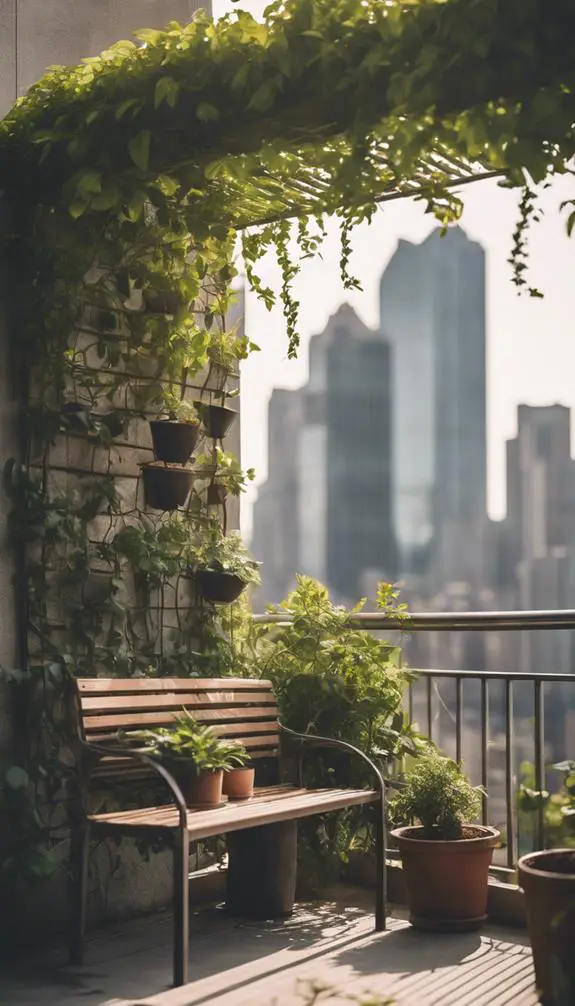
In densely populated urban areas, every inch counts, and urban gardening essentials revolve around maximizing space while minimizing maintenance.
You'll want to focus on compact, high-yielding plants that thrive in small spaces, such as vertical gardens or trellises. Urban homes often have limited natural light, so consider using grow lights or reflective surfaces to amplify available sunlight.
City dwellers should prioritize low-maintenance plants like succulents or air plants that can survive with infrequent watering. When selecting containers, opt for space-saving, self-watering planters that reduce evaporation and runoff.
Balcony Garden Makeovers

Most balconies possess a few square feet of underutilized space, waiting to be transformed into a lush oasis.
You can create a private retreat by incorporating multi-functional balcony decor that serves both aesthetic and practical purposes. Consider installing a trellis or a vertical garden planter to maximize your space.
Add a small seating area with a compact bench or a hammock, and complete the look with some vibrant textiles and string lights.
To take it to the next level, incorporate a waterproof flooring material, such as interlocking tiles or a drainage mat, to guarantee your balcony garden remains functional and beautiful even in harsh weather conditions.
Container Garden Tips

Every square inch of your small garden counts, and containers offer a versatile way to make the most of it.
When selecting a container, consider the size, material, and drainage holes to guarantee healthy root growth.
Choose a high-quality potting soil that's specifically designed for containers, as it will retain moisture but drain excess water.
Add a layer of decorative rocks or broken pottery at the bottom to improve drainage and prevent waterlogged soil.
Don't forget to incorporate garden decor, such as trellises or obelisks, to add visual interest and support climbing plants.
Mini Outdoor Kitchen Ideas

Your small garden's culinary potential is revealed with a mini outdoor kitchen, where every meal becomes an alfresco celebration.
By incorporating mini appliances, such as compact refrigerators and cooktops, you can create a functional cooking space without sacrificing style.
To maximize your outdoor decor, consider a sleek, modern design with clean lines and minimal ornamentation.
A pergola or trellis can provide shade and define the kitchen area, while a small dining set and outdoor lighting can extend the space into the evening.
With careful planning, your mini outdoor kitchen can become a vibrant hub for entertaining and relaxation, perfect for warm weather gatherings and impromptu dinner parties.
Small-Scale Composting Guide
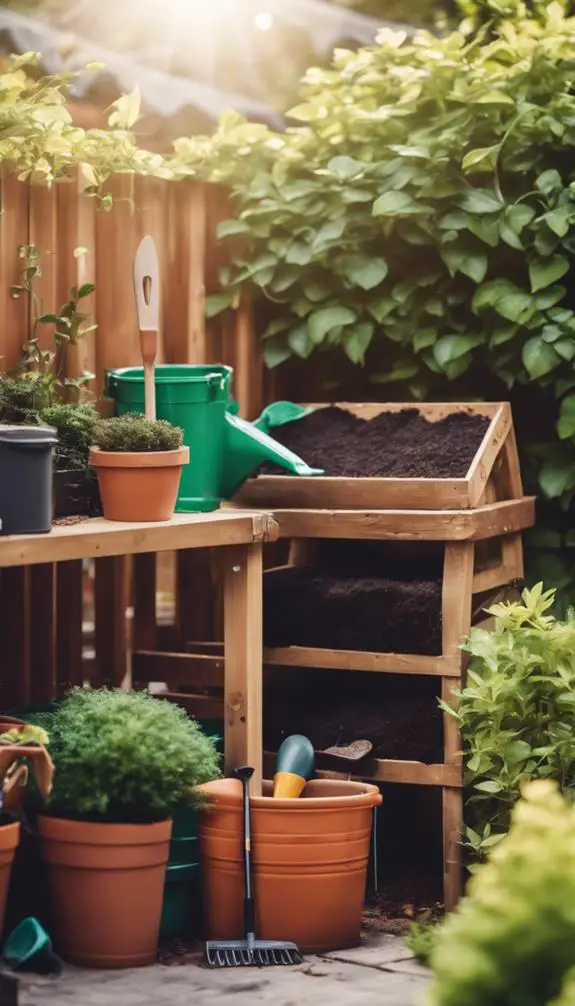
In the corner of your small garden, a nutrient-rich treasure trove awaits, fueled by kitchen scraps, fallen leaves, and coffee grounds.
To tap its full potential, you'll need to maintain your compost pile regularly. Start by layering "green" materials like kitchen scraps and "brown" materials like leaves in a 2:1 ratio.
Add water to keep the pile moist, like a damp sponge. Every few days, turn the pile to aerate it and speed up decomposition.
As the materials break down, you'll notice a rich, earthy aroma and a dark, crumbly texture. With regular compost maintenance, you'll be harvesting nutrient-dense fertilizer for your garden in no time.
Cozy Seating Area Concepts
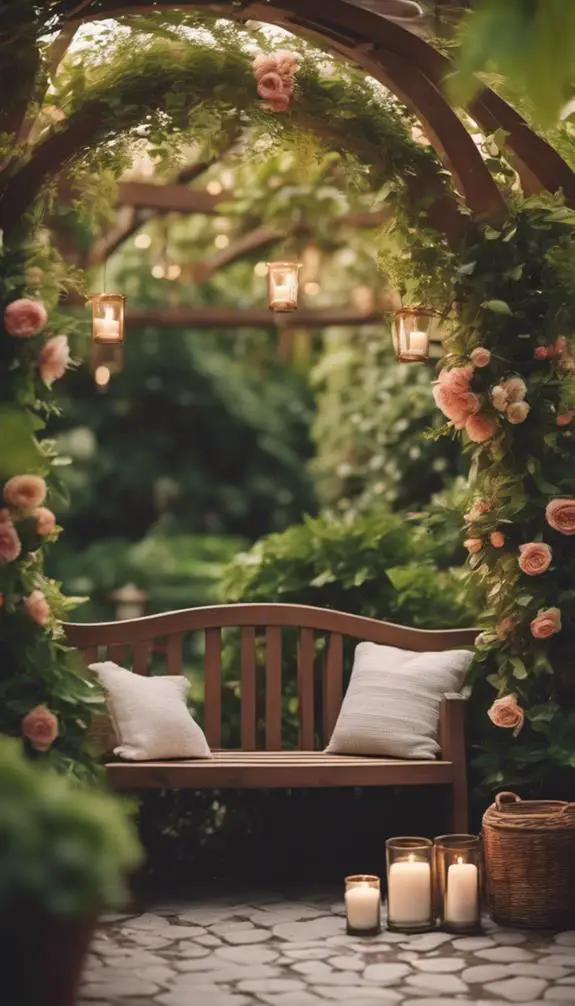
How do you envision spending leisurely moments in your small garden?
Create cozy nooks that invite relaxation by incorporating plush outdoor furniture, like a hammock or a sectional sofa, in a secluded retreat.
Consider a circular seating arrangement, which fosters conversation and a sense of togetherness.
Add warmth with throw blankets, pillows, and a fire pit or a chiminea.
To define the space, use trellises, arbors, or a pergola with vines or climbing plants.
Incorporate textures like wood, stone, or brick to add depth and visual interest.
Lighting for Small Gardens
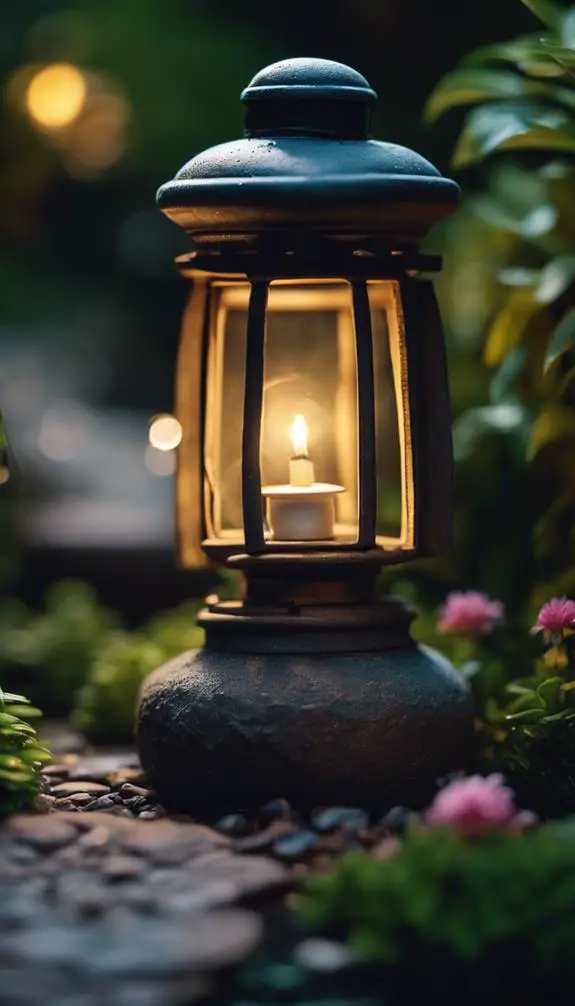
As you've crafted a cozy seating area, the next step is to illuminate it with a thoughtful lighting plan that showcases your small garden's unique features.
Consider installing pathway lights to create a Moonlit ambiance, guiding visitors through your garden's hidden nooks and crannies.
To highlight specific design elements, use spotlights or uplights to accentuate ornamental plants, water features, or architectural details.
Solar-powered lights are an eco-friendly option, providing subtle highlights during the day and soft illumination at night.
Position them strategically to create pools of light, drawing attention to your garden's most striking features.
FAQs
How Often Should I Water My Small Garden During Hot Summer Months?
During hot summer months, you should water your garden when the top 2-3 inches of soil feel dry to the touch, usually every 2-3 days, but adjust based on soil moisture levels and weather conditions to avoid overwatering.
Can I Grow Vegetables in a Garden With Partial Shade?
You can grow veggies in partial shade, but it's vital to choose varieties with high shade tolerance. Guarantee your garden receives at least 4-6 sunlight hours daily, and consider vertical or tiered planters to maximize exposure.
What Are the Benefits of Using Mulch in a Small Garden?
When you apply mulch, you'll notice it regulates soil temperatures, retains moisture, and suppresses weeds, allowing you to control the environment; with ideal mulch layers, you'll see improved soil health, increased crop yields, and reduced maintenance needs.
How Do I Keep Pests Out of My Small Garden Naturally?
To keep pests out naturally, you'll employ a multi-pronged approach: spray neem oil to disrupt insect hormones, and strategically plant companions like marigolds and basil, which repel pests, creating a fortress of defense around your prized harvest.
Can I Create a Small Garden in a Rented Property?
You can create a garden in a rented property, but first, review the rental restrictions to guarantee you're allowed to make changes. Opt for temporary landscaping solutions like container gardens or vertical planters that are easy to remove when you move out.
Conclusion
Now that you've explored these small garden ideas, you're ready to transform your compact outdoor space into a functional oasis. By incorporating vertical gardening solutions, space-saving planters, and compact patio designs, you'll create a harmonious atmosphere. Don't forget to add ambiance with strategic lighting plans and cozy seating areas. With these ideas, you'll be enjoying your miniature retreat in no time, complete with thriving plants, functional furniture, and a sense of serenity.


